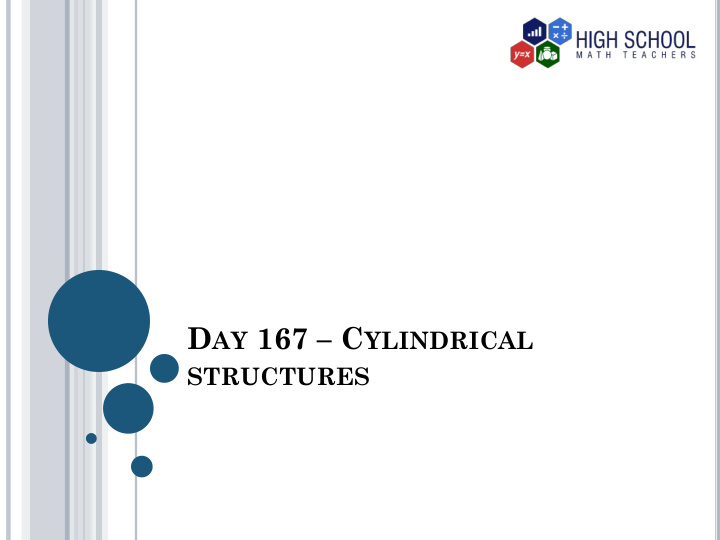



D AY 167 – C YLINDRICAL STRUCTURES
I NTRODUCTION The world surrounding us is made up of many tangible objects having different shapes and sizes based on the number of dimensions, mainly, two or three dimensions. There are a number of design problems which designers in various fields like manufacturing industries encounter in the process of designing various objects or structures. They design objects or structures with the sole aim of minimizing cost based on the physical constraints. In order to use the least available materials or to minimize the cost of production, they end up applying geometric methods.
In this lesson, we are going to learn how to apply geometric methods to solve design problems of cylindrical structures or objects with the aim of satisfying physical constraints or minimizing cost.
V OCABULARY 1. Cylinder A solid with a uniform cross-section made up of circular, flat and identical ends connected by a curved surface. 2. Physical constraint A limit or restriction on supply or availability of a physical quantity or a natural property.
M ODELLING A mathematical model is the representation and expression of a real-life system using concepts in mathematics. Modeling is the application of mathematical techniques to basically understand and solve real- world problems that arise in various fields. Equations and graphs are used to represent the various mathematical models that arise in the real world. Various concepts involving trigonometry, calculus, and geometry are applied in modeling.
In this lesson, we will use geometric concepts and knowledge of properties of cylindrical structures and formulae to find the surface area and volume of cylinders to solve design problems. We will come up with solutions to design problems using volume and surface area formulae for cylinders.
We should recall the following formulae for both volume and surface area of cylinders: 𝐖𝐩𝐦𝐯𝐧𝐟 𝐩𝐠 𝐛 𝐝𝐳𝐦𝐣𝐨𝐞𝐟𝐬 = 𝝆𝒔 𝟑 𝒊 , where 𝑠 is the radius of the base of the cylinder. 𝐓𝐯𝐬𝐠𝐛𝐝𝐟 𝐛𝐬𝐟𝐛 𝐩𝐠 𝐛 𝐝𝐦𝐩𝐭𝐟𝐞 𝐝𝐳𝐦𝐣𝐨𝐞𝐟𝐬 = 𝟑𝝆𝒔 𝟑 + 𝟑𝝆𝒔𝒊 , where 𝑠 is the radius of the cylinder and ℎ is the height of the cylinder. 𝐓𝐯𝐬𝐠𝐛𝐝𝐟 𝐛𝐬𝐟𝐛 𝐩𝐠 𝐛𝐨 𝐩𝐪𝐟𝐨 𝐝𝐳𝐦𝐣𝐨𝐞𝐟𝐬 = 𝝆𝒔 𝟑 + 𝟑𝝆𝒔𝒊 , where 𝑠 is the radius of the cylinder and ℎ is the height of the cylinder.
S OLVING DESIGN PROBLEMS In order to solve design problems related to cylindrical structures we need to: 1. Understand the situation or the problem clearly 2. Identify the final objective(s) 3. Decide which geometrical concepts should be applied in order to achieve the final objective. 4. Work on the problem systematically.
Illustration A designer intends to design an open cylindrical container to have a surface area of 6𝜌 square inches. What height, ℎ and radius, 𝑠 of the cylinder will enable him to maximize the volume of the cylinder? Solution The problem is to identify the height and radius of the cylindrical container that will give the maximum volume with a surface area of 6𝜌 . The surface area of the container will be given by: 𝜌𝑠 2 + 2𝜌𝑠ℎ since it is open.
We are to maximize volume, V subject to the constraint, surface area, A. Maximize: 𝑊 = 𝜌𝑠 2 ℎ … (1) Constraint: 𝐵 = 𝜌𝑠 2 + 2𝜌𝑠ℎ = 6𝜌 … (2) We solve for ℎ in (2) and substitute the result into (1) 𝜌𝑠 𝑠 + 2ℎ = 6𝜌 𝑠 + 2ℎ = 6𝜌 𝜌𝑠 2ℎ = 6 𝑠 − 𝑠
ℎ = 6 − 𝑠 2 2𝑠 Substituting in (1) we have, 𝑊 = 𝜌𝑠 2 6 − 𝑠 2 2𝑠 Opening the brackets and simplifying, we have: 𝑊 = 3𝜌𝑠 − 1 2 𝜌𝑠 3 We differentiate V with respect to 𝑠 and have: 𝑊 ′ = 3𝜌 − 3 2 𝜌𝑠 2
In order to maximize volume, we equate the derivative to 0. 3𝜌 − 3 2 𝜌𝑠 2 = 0 The equation simplifies to: 𝜌 3 − 3 2 𝑠 2 = 0 3 2 𝑠 2 = 3 𝑠 = 2
We then substitute the value of 𝑠 in the equation ℎ = 6 − 𝑠 2 2𝑠 in order to find the value of h. ℎ = 6 − 2 = 2 2 × 2 2 Therefore the height and radius of the cylindrical container that will give the maximum volume are 2 2 and 2 inches respectively.
HOMEWORK A designer wants to find the actual height and radius of a cylindrical water tank that will enable it to have the least surface area. If the tank is to have a capacity of 4 cubic feet, find the radius and height that will enable him to achieve this. (Give the dimensions of the tank correct to 2 decimal places)
A NSWERS TO HOMEWORK Radius = 0.86 ft. and height 1.72 feet
THE END
Recommend
More recommend